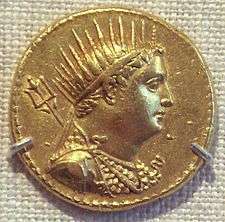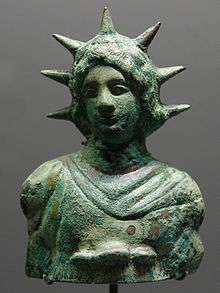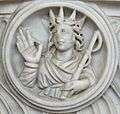Radiant crown
A radiant or radiate crown, also known as a solar crown or sun crown, is a crown, wreath, diadem, or other headgear symbolizing the sun or more generally powers associated with the sun. It typically takes the form of either a horned disc to represent the sun, or a curved band of points to represent rays.
In the iconography of ancient Egypt, the solar crown is taken as a disc framed by the horns of a ram[1][2] or cow. It is worn by deities such as Horus in his solar or hawk-headed form,[3] Hathor, and Isis. It may also be worn by pharaohs.[4]
In Ptolemaic Egypt, the solar crown could also be a radiate diadem, modeled after the type worn by Alexander the Great (as identified with the sun god Helios) in art from the mid-2nd century BC onward.[5] It was perhaps influenced by contact with the Shunga Empire,[6] and a Greco-Bactrian example is depicted at the great stupa of Bharhut.[7] The first ruler of Egypt to wear this version of a solar crown was Ptolemy III Euergetes (246–222 BC)[8]
In the Roman Empire, the solar crown was worn by Roman emperors in association with the cult of Sol Invictus,[9] influenced also by radiant depictions of Alexander.[10] The solar crown worn by Constantine, the first emperor to convert to Christianity, was reinterpreted as representing the "Holy Nails".[11]


 Amen-Re, wearing a tall feather crown and sun disk (715–664 BC)
Amen-Re, wearing a tall feather crown and sun disk (715–664 BC)- Coin issued by Alexander, King of Epeiros (333-330 BC)
 Coin of Ptolemy IV Philopator, depicting his deified father Ptolemy III
Coin of Ptolemy IV Philopator, depicting his deified father Ptolemy III Helios wearing the chlamys (Tripoli, 1st century AD)
Helios wearing the chlamys (Tripoli, 1st century AD) Helios in a clipeus, detail from a Roman sarcophagus, early 3rd century AD
Helios in a clipeus, detail from a Roman sarcophagus, early 3rd century AD
See also
References
| Wikimedia Commons has media related to Category:Radiant crowns. |
- ↑ Teissier 1996, p. 185
- ↑ Cooney 2012, p. 149
- ↑ Teissier 1996, p. 50
- ↑ Teissier 1996, p. 122
- ↑ Stewart 1993, p. 246
- ↑ Stewart 1993, p. 180
- ↑ Stewart 1993, p. 180
- ↑ Stewart 1993, pp. 142, 246
- ↑ Bardill 2012, p. 114
- ↑ Stewart 1993, p. 246
- ↑ Lavan 2011, p. 459
Sources
- Bardill, Jonathan (2012), Constantine, Divine Emperor of the Christian Golden Age, Cambridge University Press
- Cooney, Kathlyn M. (2012), "Apprenticeship and Figures Ostraca from the Ancient Egyptian Village of Deir el-Medina", Archaeology and Apprenticeship: Body Knowledge, Identity, and Communities of Practice, University of Arizona Press
- Lavan, Luke (2011), "Political Talimans? Residual 'Pagan' Statues in Late Antique Public Space", The Archaeology of Late Antique 'Paganism', Brill
- Stewart, Andrew (1993), Faces of Power: Alexander's Image and Hellenistic Politics, University of California Press
- Teissier, Beatrice (1996), Egyptian Iconography on Syro-Palestinian Cylinder Seals of the Middle Bronze Age, Orbis Biblicus et Orientalis Series Archaeologia, 11, Fribourg Switzerland: University Press
